
by Larry Williams | Apr 28, 2022
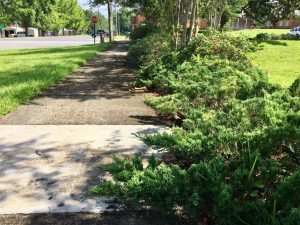
Misplaced junipers growing over sidewalk. Photo credit: Larry Williams
A number of years ago, I had the opportunity to speak at the International Flower and Garden Festival at Epcot in Orlando. I provided eight presentations on the topic “Right Plant, Right Place.”
The audiences consisted of people mostly from Florida but there were attendees from other parts of the U.S. and even from other countries. I started each presentation with the question, “Do any of you have all the right plants in all the right places in your landscape?” Not a single hand was raised in response to this question.
Most people do not have all the right plants in all the right places in their landscapes, including myself. Hopefully, no one is on the other extreme of having all the wrong plants in all the wrong places, either.
Most people fall somewhere in between these two extremes. As a Florida gardener, you’d be wise to better implement this idea into your landscape.
Right plant, right place does require some knowledge of your property’s site conditions and knowledge of plants to be used on the site. The main idea is to best match the plants to the existing site conditions.
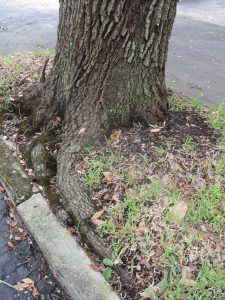
Misplaced large oak tree that needs more root space. Photo credit: Larry Williams
How often do we place shade loving plants in full sun or poor salt tolerant plants along the coast or plants that are native to wet areas such as wax myrtles on deep sandy, dry sites? These misplaced plants will not be “happy” and eventually will have problems.
How often do we take a plant in a gallon size container, plant it under a low window and expect it to stay the same size? Or, what about the sixty-foot tree under a twenty-foot power line. Plants are designed to grow.
Find out the mature size, in height and width, and place the plant where it has plenty of room to develop into its mature size.
Right plant, right place involves choosing plants that will standup to our wind, climate, humidity, heat, rain, winter weather, etc. Certain plants such as tulip and lilac don’t perform well here because of the lack of sufficient cold weather and the fact that it becomes too hot too early. But we can grow other flowering bulbs such as amaryllis and other flowering shrubs and trees such as crape myrtle and chaste tree.
With some planning and forethought in selecting and placing plants, your Florida landscape can be aesthetically pleasing, easier to maintain and more Florida-friendly.
For additional information on selecting the right plants for your landscape, contact the UF/IFAS Extension Office in your county or visit the below website https://ffl.ifas.ufl.edu.

by Larry Williams | Mar 24, 2022
Calibrating or determining the rate of water your sprinkler system applies is an easy job.
Here’s how to do it:
- Obtain 5 to 10 straight-sided empty cans such as tuna fish or soup cans.
- Place the containers randomly within the irrigated area so that they catch the water when the irrigation system is running. This needs to be done for each irrigation zone, separately.
- Turn the water on for 15 minutes.
- Use a ruler to measure the depth of water in each can. The more exact your measurement, the better your calibration will be. Measurements to the nearest 1/8 inch are adequate.
- Determine the average depth of water collected in the cans (add up the depths of water measured in each can and then divide by the number of cans).
- To determine the irrigation rate in inches per hour, multiply the average depth of water times four. For example, if you collected an average of ¼ inch of water in the cans as a result of letting the irrigation run for 15 minutes, the irrigation zone would need to run for 30 minutes to apply ½ inch of water, or 45 minutes to apply ¾ inch of water, etc.
It’s best to do this calibration exercise during the same time of day the system normally runs so that water pressures are similar.
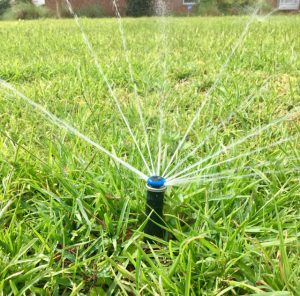
Irrigating lawn. Photo credit: Larry Williams
Here’s why calibrating your system is important.
When a timer/controller is set to come on frequently for short intervals of time (every other day for 20 minutes for example), the result will be a shallow, weak root system and a lawn that becomes dependent on its shallow roots being watered frequently. Also, watering frequently benefits certain weeds such as dollarweed and nutsedge while weakening the lawn.
To develop a deep, strong root system and a lawn that will go through hot, dry weather in better shape without requiring water as often, switch the automatic timer to manual.
Watering a lawn on an as needed basis is the best way to water correctly and develop a deep-rooted lawn. This is the reason for calibrating your irrigation system. You should apply ½ to ¾ inch of water to the lawn only when the grass indicates that water is needed. When the grass needs water, the leaf blades fold along the midrib (like a book closing). Also, footprints or tire tracks remain in the lawn long after being made. And, the lawn turns grayish in spots, indicating it needs water.
When 30 to 40 percent of the lawn shows these signs of water need, turn the irrigation system on and let it run long enough to apply ½ to ¾ inch of water. Don’t water again until the lawn begins to show these signs of water need. Don’t water when adequate rain has occurred.
The best time to observe these signs of water need is during the evening when the grass is not in full sun or under heat stress. It’s best to irrigate during early morning hours to prevent lawn diseases and to minimize water lose due to wind and evaporation. The lawn grass is a great indicator for when most other established plants in a landscape need water as well.

by Larry Williams | Feb 10, 2022
February can be a confusing month for North Florida gardeners. Winter isn’t over. So, don’t let spring fever cause you to make some gardening mistakes. Let’s take a look at some dos and don’ts of February gardening.
Despite colder temperatures that we can experience this month, it’s still okay to plant trees and shrubs from containers. The roots are better protected in the ground and will quickly grow outward to establish as compared to being exposed to cold temperatures above ground, confined in a container. But be cautious about planting cold sensitive tropical plants too soon while freezing weather is likely. Bare-root trees and shrubs should be in the ground promptly. This includes bare-root nut and fruit trees, pine and hardwood tree seedlings and bare-root roses. Dormant season planting allows time for establishment before hot weather arrives.
February is a good time to transplant or move trees and shrubs that are in the wrong place. Consider moving plants that require pruning to force them to “fit” into small or confined spaces. Move them to an appropriate location where they can grow to full size. Then you can plant something new and appropriately sized for replacement. Of course, they need to be reasonable in size to move.
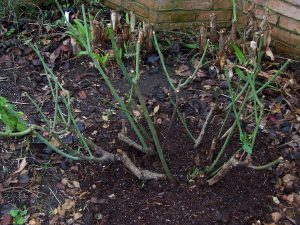
Bush rose plant correctly pruned. Photo credit: Matt Orwat
Late February is a good time to prune overgrown shrubs such as ligustrum and holly. These plants usually respond well to severe pruning, if necessary. But remember, they will eventually regrow to their larger size. Prune to shape and thin broadleaf evergreens and deciduous flowering trees such as oleander, crape myrtle and vitex. Avoid severely pruning narrow leaf evergreens such as junipers because they have few buds on old wood from which to form new growth. Mid-February is a good time to prune bush roses, removing dead or weak canes. Leave several healthy canes and cut these back to about eighteen inches. Delay doing much pruning on early spring flowering shrubs such as azalea until shortly after they flower. Pruning these plants now will remove present flower buds before they can open. Prune deciduous fruit trees such as peach, plum and apple. Now is also the time to prune ornamental grasses such as muhly grass.
If your lawn has a history of problems with summer annual weeds such as crabgrass, apply a preemergence herbicide. This should be done February 15 to March 1 when day temperatures reach 65° to 70°F for 4 or 5 consecutive days. A second application may be needed eight weeks later. Many people fertilize their lawns too early. Wait until mid-April to fertilize to prevent lawn injury and for the most efficient use of the fertilizer.

by Larry Williams | Jan 6, 2022
Q. When is citrus fruit ready to harvest?
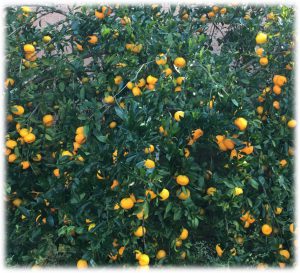
Satsuma fruit ready to harvest. Photo credit: Larry Williams
A. Florida uses five indexes to determine maturity of citrus, including soluble solids, juice content, acid level, soluble solids/acid ratio and skin color. But, the home gardener can easily decide when most citrus types are ready to be harvested. As the fruit reaches full size and the skin color changes from green to greenish yellow to orange, simply pick some fruit and taste it to see if it is sweet. If not, wait a little longer (a week or two) and taste test another fruit. Meyer lemons are ready when the skin color changes from green to greenish yellow. Satsuma fruit may be ready to eat before the skin becomes completely orange, especially if the early fall is warm. Kumquats are usually at their peak in taste when they become fully orange.
Citrus fruit does not ripen additionally after it is harvested. So, let it mature sufficiently on the tree.
Harvest season for satsuma is October to December. Harvest season for Meyer lemon is November to March. Harvest season for kumquat is November to April. Most grapefruit have a harvest season from November to May. Harvest season for sweet oranges varies. Early season oranges are harvested October to January, mid-season oranges are harvested December to February and late-season cultivars are harvested March to June. Citrus fruit may mature a little earlier in the harvest season on mature trees and more toward the end of the harvest season on young, vigorous trees.
Q. What cold-hardy citrus is best for North Florida?
A. Citrus species are tropical and subtropical in origin. As a result, citrus is not well suited for extreme North Florida. Commercial citrus production has progressively moved further south in Florida due to historic freezes. So, you’d be wise to choose the more cold-hardy citrus types for our area. But, even cold-hardy citrus can be severely injured or killed by a hard freeze in North Florida.
Some of the better choices for cold-hardy citrus in North Florida include kumquat, satsuma, calamondin and Meyer lemon. There has been some success with grapefruit and sweet oranges in our area. Lemon and lime are much less likely to survive in North Florida. There has been some discussion concerning future success with growing citrus a little more north in its current range related to climate change. There already has been some success with growing the more cold-hardy citrus types such as satsuma and kumquat in middle Georgia. We’ll see how this works out.
More information on cold-hardy citrus is available from the UF/IFAS Extension Office in your County and through this link. https://crec.ifas.ufl.edu/extension/trade_journals/2018/2018_june_coldhardy.pdf
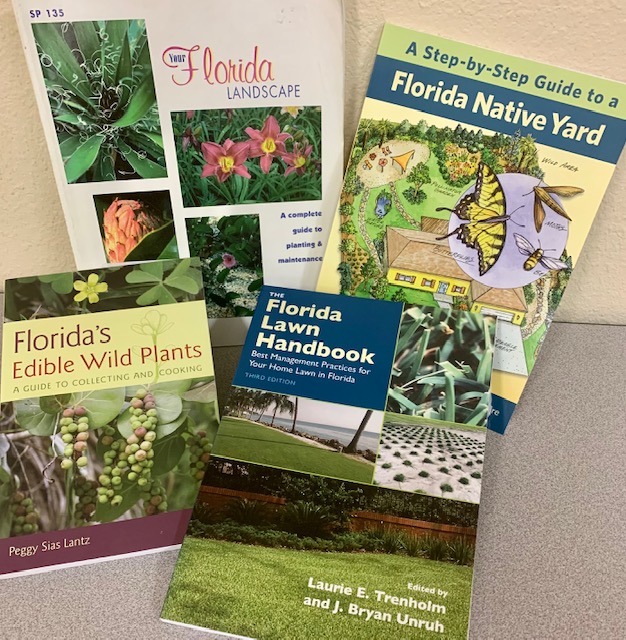
by Larry Williams | Dec 10, 2021
Christmas is on its way and it’s time to buy those gifts. If there is a gardener on your gift list, consider a gardening gift.
There are all sorts of gift ideas for a gardener and the price range varies as well.
A subscription to a garden magazine may be just the idea that your gardener will enjoy throughout the year. Look for those published in Florida or at least in the Southeast.
You might consider a horticulture book. There are many from which to choose, including those written by local authors. Check with your favorite bookstore and see if it includes a section on local writers.
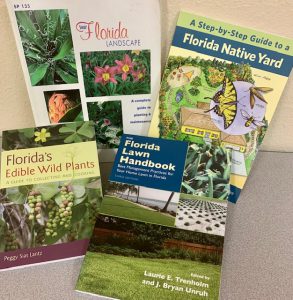
Examples of books from IFAS/Extension Bookstore. Photo credit: Larry Williams
The University of Florida’s Institute of Food and Agricultural Sciences (UF/IFAS) Extension Bookstore has numerous for sale books, posters, DVDs and more. Florida’s Edible Wild Plants is a 154-page book fully illustrated with photos and drawings to assist with identification of many of Florida’s edible plants. It includes a cookbook section with recipes and an important chapter on what not to eat. The popular Your Florida Landscape: A Complete Guide to Planting and Maintenance is a 234-page book packed full of information on landscape plants, common pests as well as beneficial insects. View and order items online at this website. http://ifasbooks.ifas.ufl.edu While there check out the section on “Books for $1,” “Logo Products” and “Pollinators & Native Plants.”
What about a gift certificate to a botanical garden such as Bellingrath Gardens or Callaway Gardens or to a local nursery/garden center?
You could make a gift basket. Be creative. Place small gardening tools such as hand pruners, a garden trowel, gardening gloves, seed packets, seed catalogs or other such items in a basket or five-gallon bucket (always handy for gardeners). Enclose with colored cellophane wrap, tie with ribbon and there you go – a nice gift.
There are more expensive items such as garden carts, benches or decorative garden art for the landscape. What about a birdhouse, bat house, birdbath or birdfeeder? You might look for a unique gift such as a mushroom kit containing everything needed to grow fresh edible mushrooms. A decorative stepping stone, outdoor thermometer, a pack of weather proof plant labels or a bug vacuum might be the gift of choice. You haven’t heard about the bug vacuum? I have one. It was a gift. It’s used to vacuum small insects off of indoor plants or to sample for insects.
Oh, and I haven’t mentioned gift plants. Your imagination is the limit when picking out a gift for a gardener. Your gift may be expensive, inexpensive, handmade, purchased from a store… I’ve been told it’s the thought that counts.











